LONDON — Iran has entered its 10th day of nationwide protests over the death of 22-year-old Mahsa Amini while in police custody. Amini had been detained by morality police on Sept. 13 for allegedly violating a religious law that decrees that a woman should wear a headscarf. She died three days later.
Activists and Amini’s family believe she died from injuries sustained from a beating by police. Authorities in Iran, however, deny any mistreatment and claim that Amini suffered “sudden heart failure.”
Public anger over Amini’s death has sparked some of the biggest protests Iran has seen in years. Demonstrations led by women have been held across 90 cities and towns in the Islamic Republic in the past week. Social media has been flooded with videos of what appears to be women burning their hijabs and cutting off their hair in public acts of defiance.
But as public outcry appeared to reach new heights, both online and on the streets, Iran’s government reacted by shutting off the internet to multiple cellular networks. Videos that were uploaded before the blackout show protesters fighting back against the government’s security forces. On Saturday, Iranian officials said they would continue to restrict internet access until the protests cease, CNN reported.
This appears to be just the beginning of Iran’s crackdown on dissent in the country. On Friday, the military hinted that it was prepared to “confront the enemies’ various plots in order to ensure security and peace for the people who are being unjustly assaulted,” Reuters reported.
Elsewhere in Iran, pro-government rallies took place in cities on Friday in response to the nationwide protests over Amini’s death. Reuters reported that chants such as “Offenders of the Koran must be executed” could be heard from the crowds.
The demonstrations over Amini’s death are the latest in a string of protests over the past several years in which Iranians have fought back against their government on a number of issues. In every instance, however, the Islamic Republic’s forces fought to quell the rebellion.
About three years ago, hundreds of protesters took to the streets after a decision by the authorities to raise the price of gasoline by at least 50%. In what was later labeled as “Bloody November,” hundreds of civilians were killed and demonstrations were violently crushed by government forces. It was the deadliest instance of political unrest in Iran since the 1979 revolution.
“In November 2019, Iranian authorities coupled the brutal crackdown with a near blackout of the internet, so that Iranians were cut off from the outside world,” Dr. Assal Rad, research director of the nonprofit National Iranian American Council, told Yahoo News.
Iran’s state television would later acknowledge that security forces had fatally shot “rioters.” Among the dead were peaceful protesters and passersby, the report also stated.
But this time it seems as though the government’s response might be larger and deadlier.
“The fact that we are seeing protesters openly confronting security forces and fighting back in this unprecedented manner may indicate a larger and deadlier crackdown than what we have seen in the past, as authorities try to repress protests that have spread across the country,” Rad said.
“If precedence is any indication, Iranian authorities have shown that they will use deadly force, mass arrests and control over communications to suppress protests.” She added: “In that respect, Iranian authorities have shown that they will go to any length to ensure their own survival over the rightful needs and demands of the people of Iran.”




